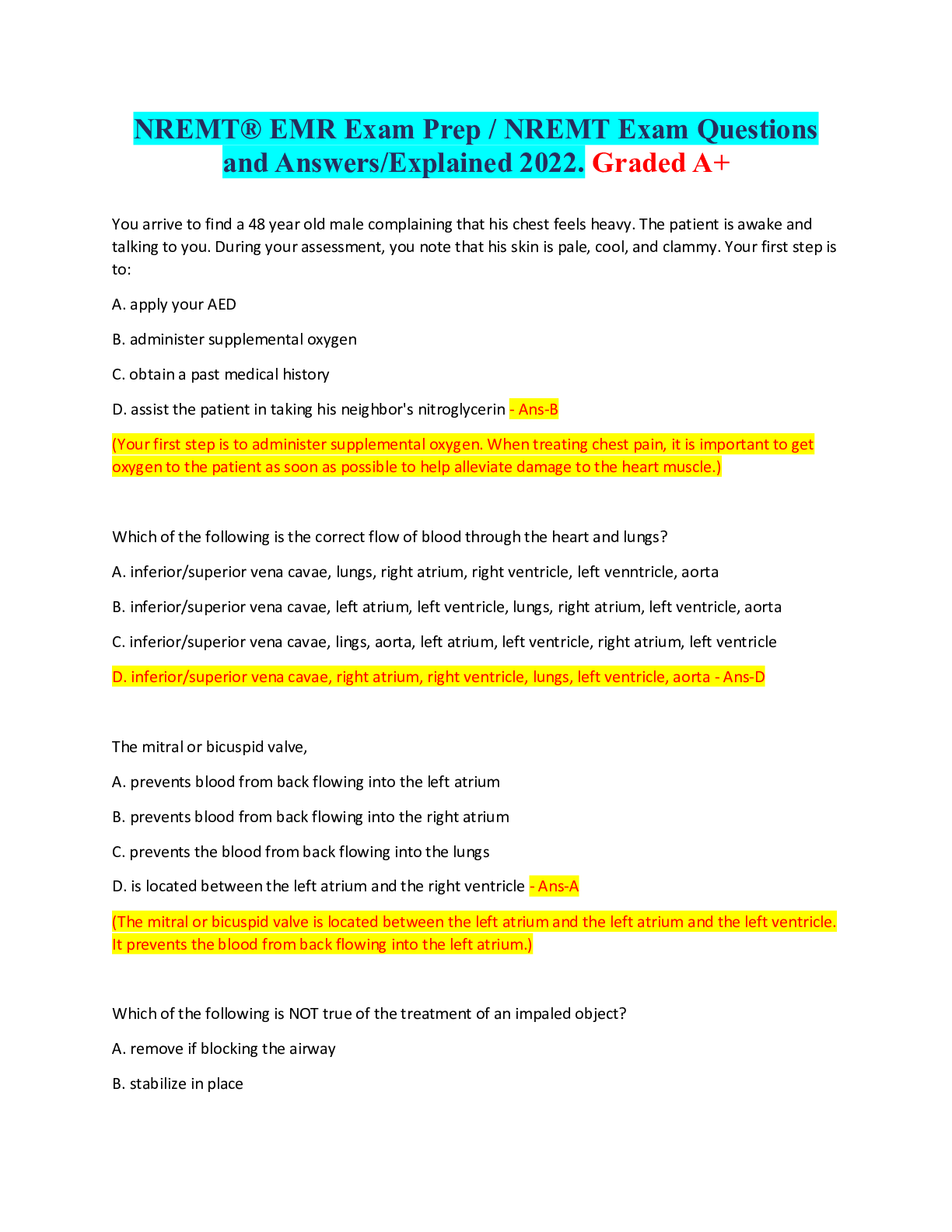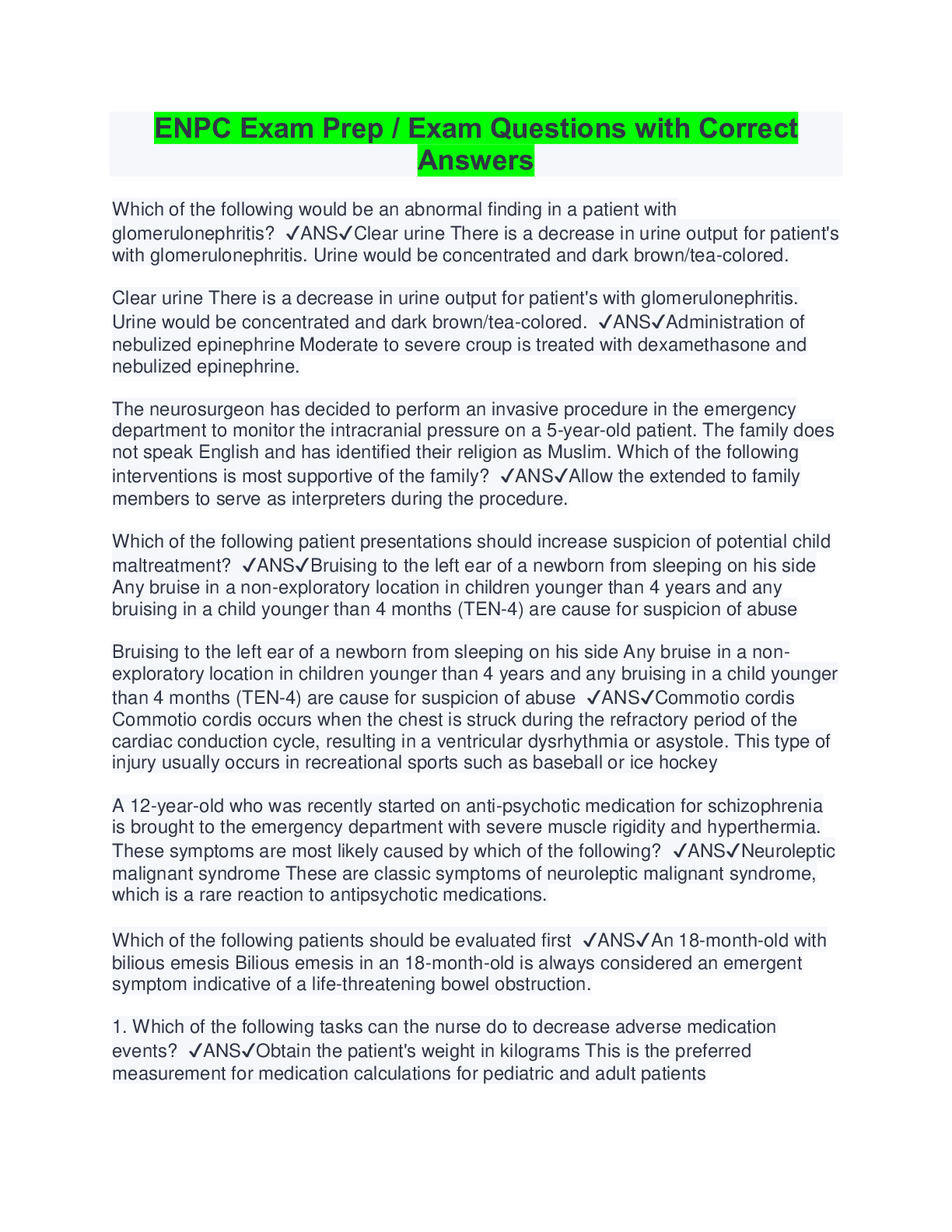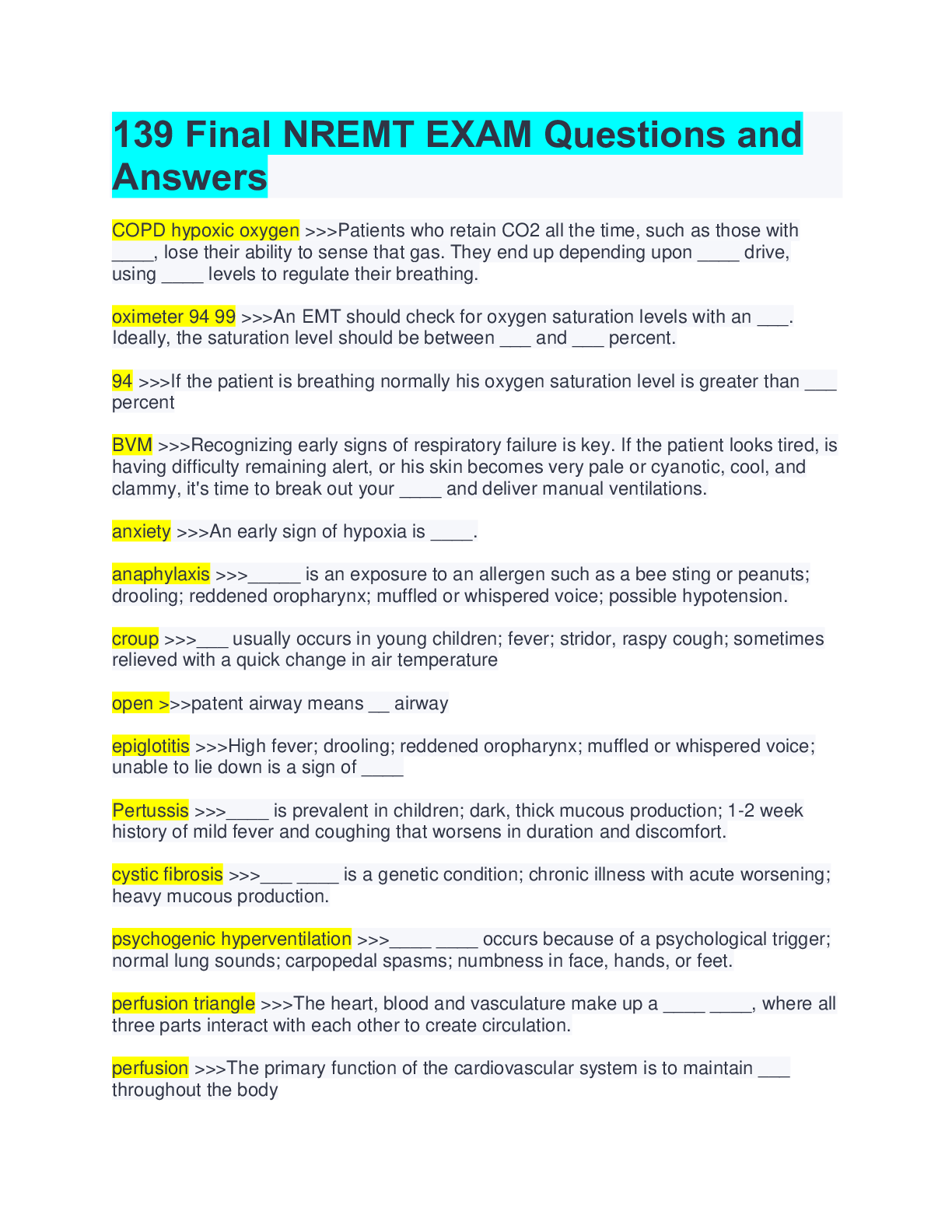Health Care > QUESTIONS & ANSWERS > NREMT® EMR Exam Prep / NREMT Exam Questions and Answers/Explained 2022. Graded A (All)
NREMT® EMR Exam Prep / NREMT Exam Questions and Answers/Explained 2022. Graded A
Document Content and Description Below
You arrive to find a 48-year-old male complaining that his chest feels heavy. The patient is awake and talking to you. During your assessment you note that his skin is pale, cool, and clammy. Your fir... st step is to A.) apply your AED B.) administer supplemental oxygen C.) obtain a past medical history D.) assist the patient in taking his neighbor's nitroglycerin - ☑☑B- administer supplemental oxygen When treating chest pain it is important to get oxygen to the patient as soon as possible to help alleviate damage to the heart muscle Which of the following is the correct flow of blood through the hear and lungs? A.) inferior/superior vena cave, lungs, right atrium, left atrium, right ventricle, left ventricle, aorta B.) inferior/superior vena cave, left atrium, left ventricle, lungs, right atrium, left ventricle, aorta C.) inferior/superior vena cava, lungs, aorta, left atrium, left ventricle, right atrium, left ventricle D.) inferior/superior vena cava, right atrium, right ventricle, lungs, left atrium, left ventricle, aorta - ☑☑D- inferior/superior vena cava, right atrium, right ventricle, lungs, left atrium, left ventricle, aorta The mitral or bicuspid valve A.) prevents blood from back flowing into the left atrium B.) prevents blood from back flowing into the right atrium C.) prevents the blood from back flowing into the lungs D.) is located between the left atrium and right ventricle - ☑☑A- prevents blood from back flowing into the left atrium The electrical impulse generated in the right atrium is called the A.) atrioventricular node B.) purkinje fibers C.) sinoatrial node D.) bundle of his - ☑☑C- sinoatrial (SA) node it travels through both atria, causing both to contract simultaneously, which propels the blood to the ventricles Which component of blood provides an immune system for the body, defending against infections? A.) red blood cells B.) white blood cells C.) plasma D.) platelets - ☑☑B- white blood cells When differentiating between angina pectoris and a myocardial infarction, you know that A.) there is no difference between the two B.) angina pectoris is caused by physical or emotional stress C.) rest will relieve symptoms of a myocardial infarction D.) the pain from angina pectoris is continual and will not go away - ☑☑B- angina pectoris is caused by physical or emotional stress It usually only lasts for 3 to 8 minutes, but no longer than 10 minutes. It is usually received by rest, unlike a myocardial infarction. You arrive on the scene to discover an unconscious patient. Upon completing your primary assessment, you find the patient to be pulseless and apneic. Your next step would be to A.) begin CPR B.) give two ventilations C.) apply the AED D.) check the pulse for another 60 seconds - ☑☑A- begin CPR immediately After CPR, you would then apply the AED. It is important to deliver a counter-shock with the AED if the patient is in v-fib or pulseless v-tach. The AED is used to treat patients in A.) asystole B.) ventricular tachycardia with a pulse C.) ventricular fibrillation D.) pulseless electrical activity - ☑☑C- ventricular fibrillation The AED should only be connected to the patients that are pulseless and apneic. The AED is designed to shock those electrical rhythms that are disorganized or very fast and do not have pulses associated with them. Which of the following is the first line of defense in fighting against infectious disease? A.) vaccinations B.) hand washing C.) using BSI D.) using 100% bleach - ☑☑B- hand washing You arrive on the scene to discover a 65-year-old female lying on the floor of her living room. Your first step in the care of this patient is to A.) begin chest compressions B.) apply the AED C.) maintain an open airway D.) assess level of consciousness - ☑☑D- assess the level of consciousness You are on the scene with a patient dying from a terminal illness. The spouse of the patient begins to verbally attack you. Which emotional stage is this individual exhibiting? A.) denial B.) anger C.) bargaining D.) depression - ☑☑B- anger You arrive on the scene to find a patient who had a productive cough for the past two weeks. The patient is complaining of a fever and night sweats. Your next step would be to A.) obtain a better medical history B.) obtain vital signs C.) immediately transport the patient to the hospital D.) put your HEPA mask on - ☑☑D- put your HEPA mask on A patient with a productive cough for any length of time should be suspected for TB. Nonetheless, a mask is an important universal precaution for any patient with a productive cough to prevent the spread of any airborne infectious disease. You arrive on scene, finding an unconscious patient. There are no other individuals in the vicinity to give you any information or permission to treat the patient. Even though the patient cannot give you consent to treat him, you begin to do so because of A.) expressed consent B.) implied consent C.) advanced directives D.) emergency consent - ☑☑B- implied consent Implied consent occurs when you assume that a patient who is unresponsive or unable to make a rational decision would consent to life-saving emergency care. you arrive at an emergency room to find the nurses are too busy taking care of other patients. You are getting off shift and want to get back to you base station. You and your partner move the patient into a hospital bed, lay the report on the bed with the patient, and then leave. You and your partner have just committed A.) abandonment B.) negligence C.) appropriate patient care D.) vicarious liability - ☑☑A- Abandonment Abandonment is any time you stop caring for a patient without ensuring the patient receives equal or better care. Giving a verbal patient report coupled with a caregiver of equal or greater level of care is imperative for appropriate patient transfer of care and the avoidance of abandonment. Which of the following is NOT an appropriate scenario to give patient information? A.) another health care worker needs the information to continue medical care B.) information is required for billing purposes C.) your neighbor asks what was wrong with the patient D.) you are subpoenaed in court - ☑☑C- your neighbor asks what was wrong with the patient Which artery do you typically assess on an infant? A.) brachial artery B.) carotid artery C.) femoral artery D.) radial artery - ☑☑A- brachial artery This is the pronounced site to assess for a pulse. This is the best place to assess the pulse on any patient under the age of one. It is difficult to assess the carotid because these patients typically do not have a neck and the radial is not reliable. The condition in which a patient has a high level of sugar in his blood is called A.) hypoglycemia B.) diabetes C.) hyperglycemia D.) hyperkalemia - ☑☑C- hyperglycemia Hyperglycemia is a lack of insulin and sugar cannot enter the cells. Therefore, it remains in the bloodstream, causing a high level of sugar in the blood. You arrive on the scene of a patient who fell from a ladder. You should open the patient's airway by using A.) head-tilt/chin-lift B.) jaw-thrust maneuver C.) neck-lift/head-tilt [Show More]
Last updated: 2 years ago
Preview 1 out of 33 pages

Buy this document to get the full access instantly
Instant Download Access after purchase
Buy NowInstant download
We Accept:

Also available in bundle (2)

NREMT Bundle. all you need to pass final exam, Questions with accurate answers
consists of NREMT exam questions with answers documents, study guide. rated A+
By bundleHub Solution guider 2 years ago
$29
6

NREMT EXAM BUNDLE. QUESTIONS WITH ACCURATE ANSWERS, LATEST UPDDATES
COMPRISES OF ALL EXAMINABLE NREMT EXAM QUESTIONS WITH ACCURATE ANSWERS.
By bundleHub Solution guider 2 years ago
$32
25
Reviews( 0 )
$8.00
Can't find what you want? Try our AI powered Search
Document information
Connected school, study & course
About the document
Uploaded On
Aug 15, 2022
Number of pages
33
Written in
Seller

Reviews Received
Additional information
This document has been written for:
Uploaded
Aug 15, 2022
Downloads
1
Views
231














.png)



